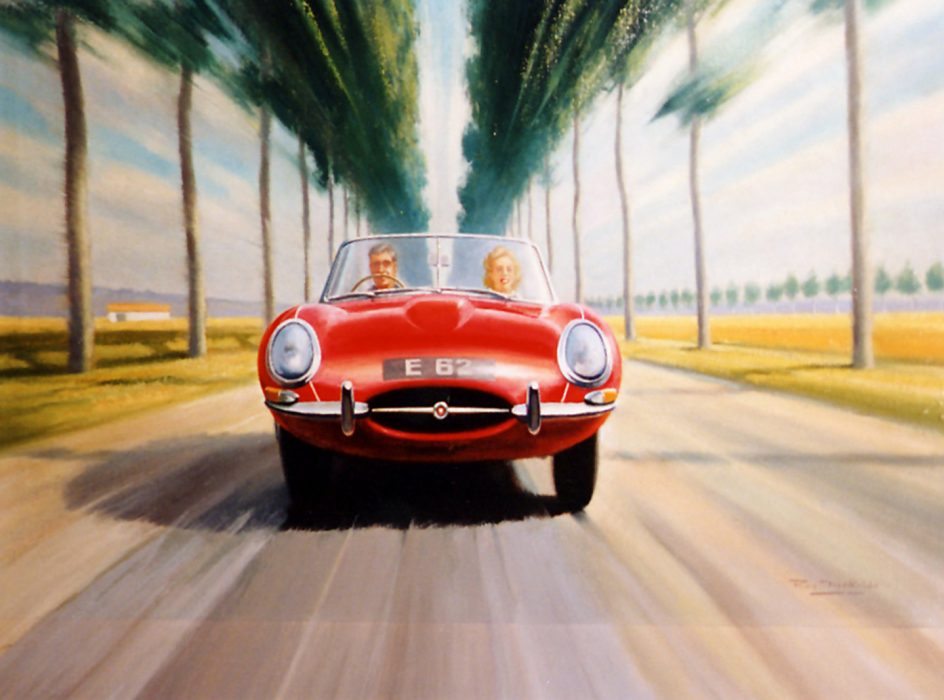
E-type – Red, Roy Nockolds, 1961
The Artwork
This is one of nine paintings by artist Roy Anthony Nockolds in the Jaguar Daimler Heritage Trust’s Collection and was commissioned by Jaguar Cars. Most of the paintings commissioned by Jaguar or suppliers were to commemorate race wins but this and one of our other paintings were commissioned for advertising and marketing purposes. Ernest (Bill) Rankin commissioned the painting in May 1961 only two months after the E-type’s launch in Geneva in March, for use as an advertising poster with the brief ‘I have an open mind concerning treatment but am not too keen on a purely racing theme (it’s early days for that) but speed of course should be strongly suggested. A French route nationale. The M.1. I leave it to you.’
Rankin was not keen on Nockolds’ first sketch as it lacked a sense of speed and sent him a photo of an E-type, taken by a photographer sitting in the boot of a Mark IX saloon, as a suggested composition. Following a further exchange of sketches the current composition was settled on which shows the car heading down a French Route Nationale, characterised by the lines of trees on both sides of the road. The original brief also asked that he portray a Coupe but Nockolds suggested, and sketched, an open two-seater which Rankin accepted.
Nockolds has succeeded in meeting Rankin’s request for movement and speed by blurring not just the tarmac road surface but also the treetops and clouds above.
The painting was used in some advertising and for publicity material at a time when very few people would have seen a real E-type on the road. It was also used on coasters and Company give-aways which were given by the Company to dealers and selected suppliers. These Company give-aways still turn up at auction and at various motor sales around the country.
We believe this is the last painting that Jaguar commissioned from Nockolds. It is NOT currently on public display.
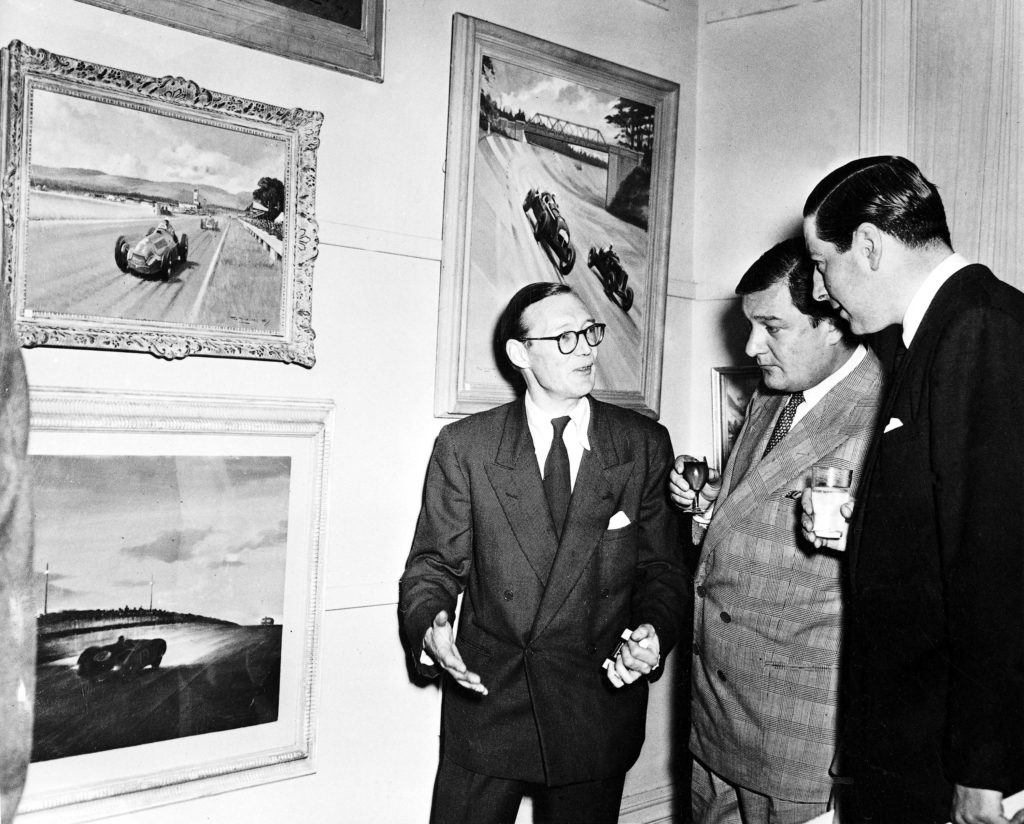
The Artist
Roy Nockolds was born in Croydon in 1911. He always claimed that his only successful subject was art and this was confirmed by two certificates from the Royal Drawing Society in 1922 (age 11) and 1923 (age 12). According to Nockolds’ recollections he first visited Brooklands in 1924 (age 13) where he became impressed by the power and speed of the racing cars and within two years, he was producing motoring art. By the time he was in his teens he was getting his pictures published in the motoring press. His early work was mainly pencil and charcoal drawings, but he also used ink, scraperboard, lino cut and dry point etching as well as watercolours.
F Gordon Crosby was already illustrating for The Autocar and Nockolds was fortunate to have most of his early work published by Motor Sport and Light Car. Although to his credit, Autocar was publishing full page reproductions of some of his etchings in 1932 (age 21). The first recorded exhibition of his work was in December 1934 at the Lombard Restaurant, Cheyne Walk, Chelsea.
Around this time he was working as a freelance artist although some of his work was being used by The Motor to illustrate a weekly series of famous corners on racing circuits.
The start of war in 1939 brought a cessation of motor racing for the duration and Nockolds carried on working from his London studio as a general illustrator and for the services, particularly the RAF producing propaganda art.
In 1942 he was asked to look at improving the camouflage of night fighters. He noticed that a white owl was more difficult to see against a night sky than a dark bird. His idea was to paint the leading edge of the wing and underside of the aircraft white and the top of the aircraft black making it difficult to see from above and below. He prepared a painted model of a De Haviland Mosquito aircraft which was transferred to a full sized plane, resulting in the whole of 151 Mosquito Squadron being converted to the new scheme within days. Other camouflage work led to him being called up into the RAF at the end of 1942, initially as a Clerk, but by 1943 he was posted to the aircraft research station at Farnborough where he had civilian status. He continued the propaganda paintings and his work on camouflage of aircraft, particularly bombers and accepted commissions to supplement his income. The end of the war saw the restart of racing and he resumed his motoring artworks including commissions from car makers such as Ford, Standard, Rover, Rolls-Royce and the Rootes Group and component manufacturers such as Lockheed and Lucas.
It was during this period that he was commissioned by Jaguar and some of the sponsors and suppliers to produce all the paintings that we have in our Artwork Collection. Nockolds’ connection with Jaguar began when the Esso Petroleum Company commissioned him to depict Le Mans 1951 when Peter Walker and Peter Whitehead drove their C-type through pouring rain to give Jaguar their first victory at Le Mans. He then worked closely with Jaguar’s PR Manager Ernest (Bill) Rankin for the next decade undertaking a series of commissions, many of race winning situations but also pictures for calendars, Christmas cards and advertising posters. He was a master of combining light and texture into his work to give the impression of speed and this comes across in several of our paintings.
His work was displayed in many exhibitions in the UK and twenty-four of his paintings were exhibited in New York in 1960 in an exhibition entitled ‘British Motoring Achievements’. This was a collection of paintings depicting outstanding performances of British cars during the previous ten years including some of our race winning Jaguar pictures.
Nockolds took a very keen interest in the Brooklands society founded in 1967, being an early Committee Member and the Chairman from 1976 to 1978, only resigning with the onset of ill health. He was elected Chairman of the Guild of Aviation Artists in 1975, and continued to paint late into his life before passing away in 1979.
1961 E-type 77 RW
The car in the painting E 62 never actually existed and was just artistic licence on Nockolds’ part.
The Jaguar Daimler Heritage Trust has the very first production open two-seater E-type built – 77 RW, in our collection. This was famously driven to Geneva overnight, in March 1961, by Jaguar test driver Norman Dewis to provide extra capacity for press drives at the E-type launch at the Parc des Eaux Vives in Geneva.
This together with the fixed head coupe used in Geneva and driven by Bob Berry, 9600 HP, are probably the two most famous E-types in the world.
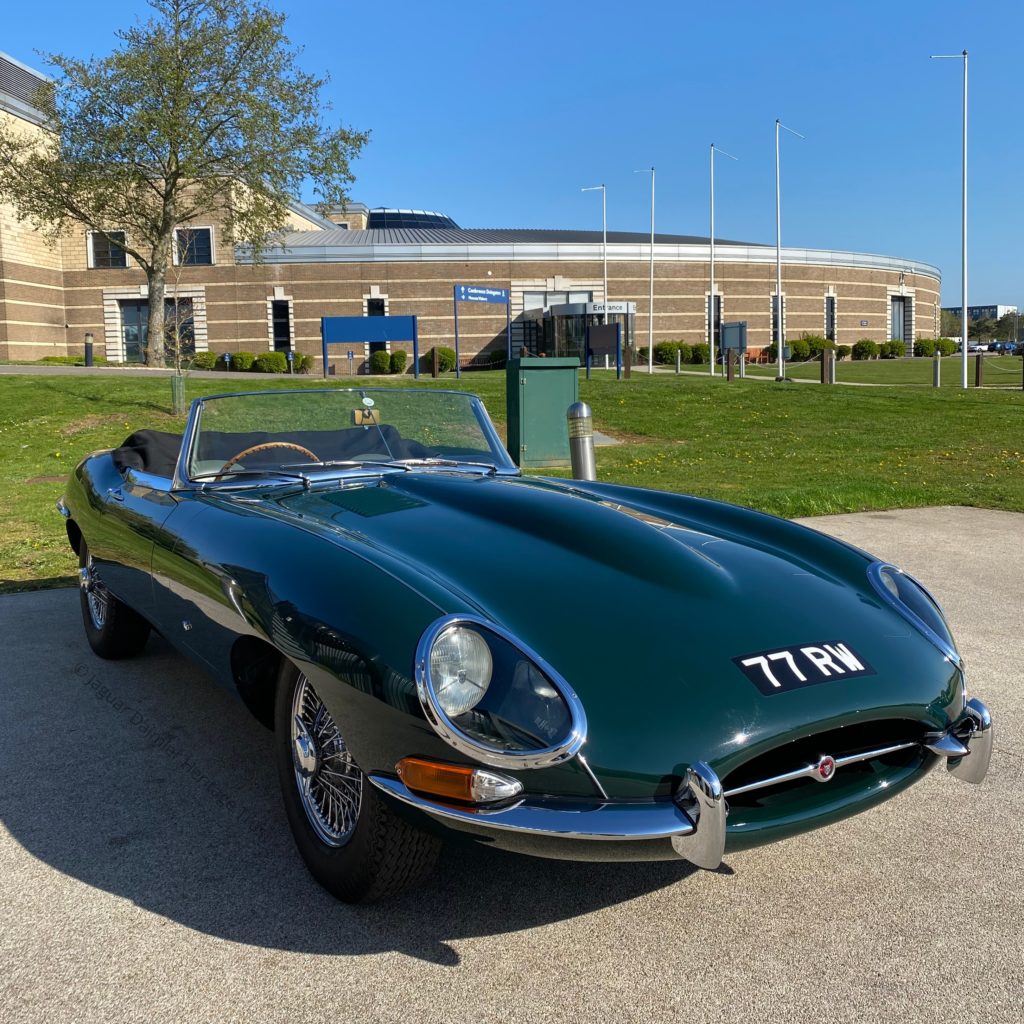
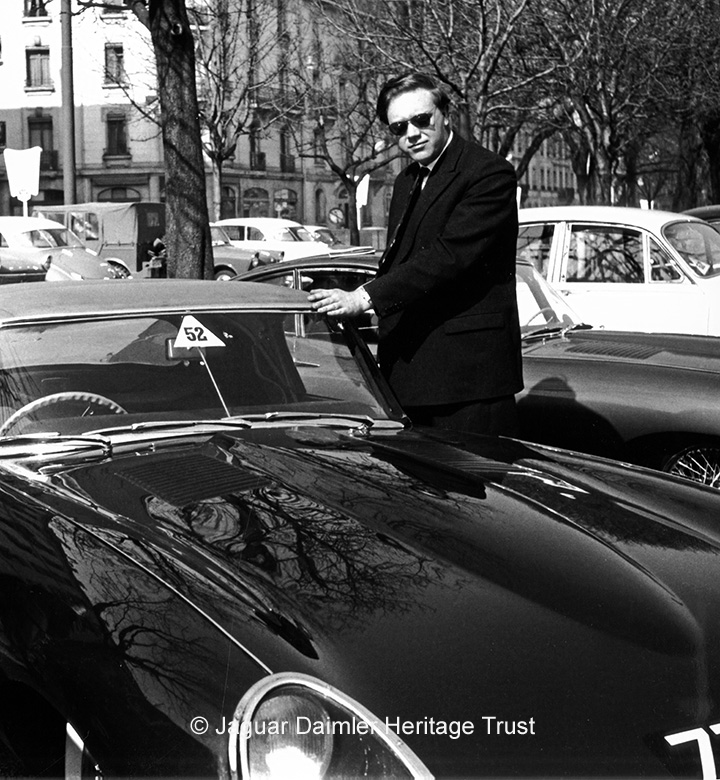
Jaguar Art Collection and E-type 77 RW
Ever since its launch in march 1961 the E-type has been the subject of numerous paintings. Some for advertising, some commemorating racing wins and some just because people love the image.
Jaguar Daimler Heritage Trust has two other items depicting E-types in our collection, both with the first E-type 77 RW as the subject.
One of these was commissioned by the Trust in 2011 to commemorate the 50th anniversary of the launch. It was painted by Ian Cook who uniquely uses remote control cars to produce his paintings, and was completed in front of a live audience at Coventry Transport Museum.
The other was commissioned by the Trust in 2021 to celebrate the 60th anniversary and was created by Richard Neergaard who produces 3D artworks on aircraft grade aluminium incorporating parts of period cars.
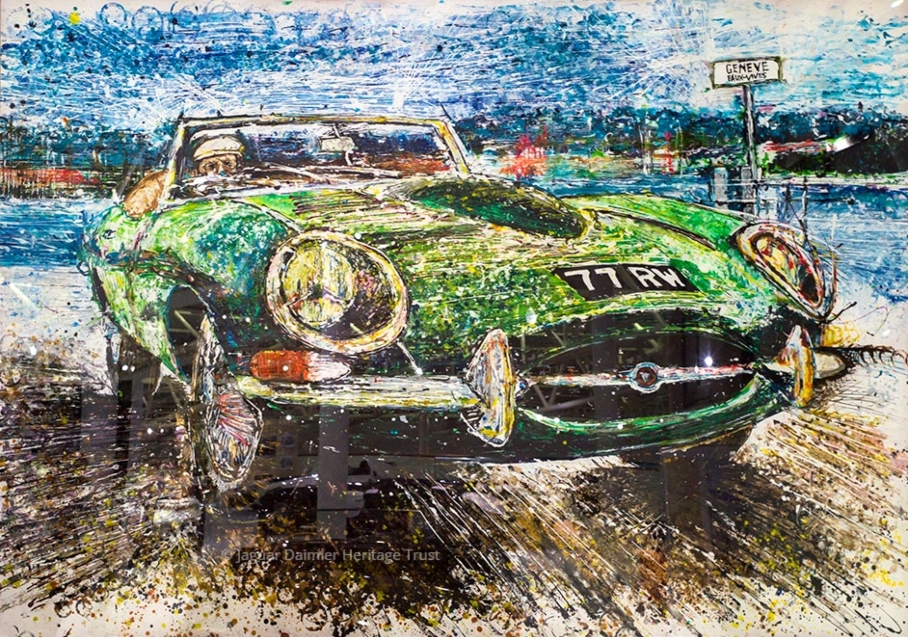
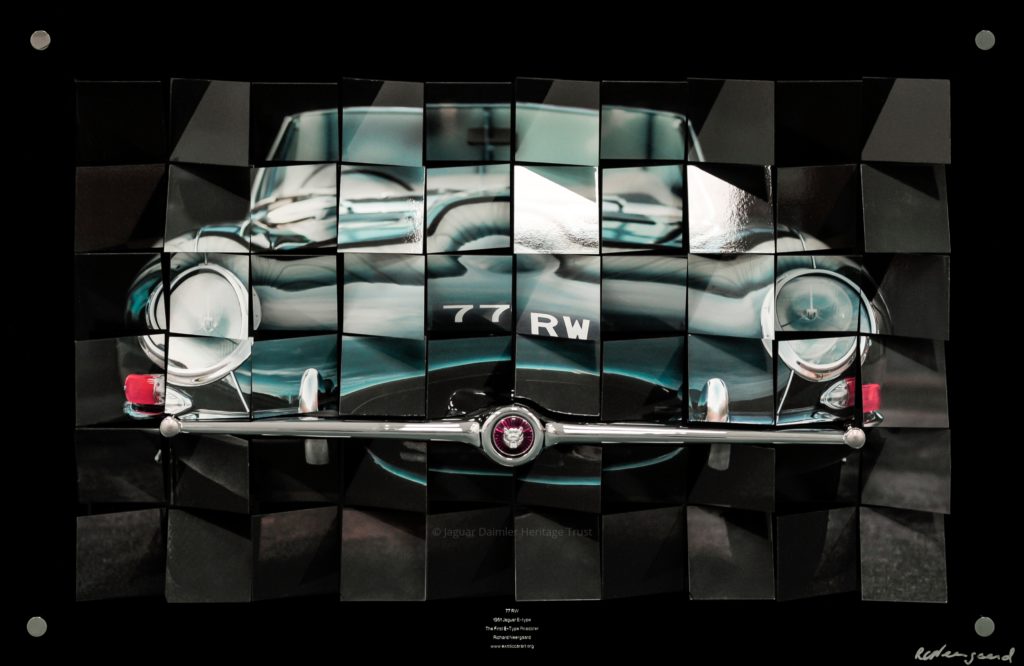
Click the button for more information on 77 RW: